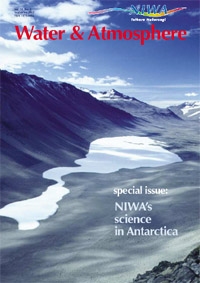PDF of this article (69 KB)

Over the last decade we have seen substantial advances in our understanding of the seas around New Zealand. Many of these advances have been made possible with the research capabilities of RV Tangaroa.
With the declaration of its Exclusive Economic Zone (EEZ) in 1978, New Zealand took on responsibility for a huge new ocean area with many new resources, including deepwater and offshore fisheries. However, provision of the science necessary for robust resource management was a challenge. At that time there was limited capacity to carry out the marine research necessary to map, assess, and model these marine resources. A deepwater research vessel was required.
Owned and operated by NIWA Vessel Management Ltd, RV Tangaroa has proved to be a highly effective floating laboratory and oceanic sampling platform in the waters around New Zealand and Antarctica. She is New Zealand’s only ice-strengthened, multipurpose research vessel.
Tangaroa was designed by Karstein Teige and his team at Skipsteknisk in Alesund, Norway, in consultation with staff of the former MAF Fisheries Research Centre. Construction of Tangaroa in Bergen took 15 months and she arrived in New Zealand in June 1991.
The 70-m long Tangaroa was purpose-built for fisheries stock assessment (using a range of techniques to sample to depths of 2000 m) and has excellent capability for other marine research, including oceanography, marine biology, geology, and geophysics. The vessel carries a broad complement of scientific facilities, including several specialised laboratories. There is also a hospital with basic facilities and an Antarctic survival container. The vessel has been equipped for research in waters from the tropics to Antarctica. Tangaroa has an ice classification of DNV-1A1 (stern trawler) + Ice 1C (light ice: ice floes up to 0.4 m thick). This has enabled Tangaroa to work effectively and safely to the edge of the Antarctic sea ice over five summers, covering both the Ross Sea sector and the Southern Ocean south of Australia.
Since commissioning, Tangaroa has spent between 320 and 340 days at sea per year. The research effort in Antarctic waters has included:

- a multi-national voyage to experimentally seed Southern Ocean waters with soluble iron and follow the phytoplankton response;
- mapping of shipping lanes and tidal monitoring in the northwestern Ross Sea and Balleny Islands for Land Information New Zealand (using swath multibeam technology);
- a preliminary assessment of marine benthic biodiversity in the northwestern Ross Sea and Balleny Islands for the New Zealand Ministry of Fisheries;
- research activities for the Australian Antarctic Division in the eastern regions of the Australian Antarctic territory;
- two oceanographic/planktonic research voyages for the Japan National Institute of Polar Research.
In February–March 2004 Tangaroa will be carrying out a 47-day joint Ministry of Fisheries/ Land Information New Zealand benthic biodiversity and seabed mapping voyage in the western Ross Sea and Balleny Islands.
Don Robertson (NIWA General Manager, Biodiversity, Biosecurity and Information Systems)
See more information about Tangaroa’s equipment and capabilities.
